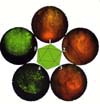Research Laboratories
Scope of Research
 Research in our laboratory centers on the study of the molecular biology of adeno-associated virus (AAV). We aim to exploit the unique features of this virus to develop an efficient viral vector system for use in human gene therapy. One unique feature that makes AAV attractive for human gene therapy is its ablity to insert its genome locus-specifically into human chromosome. Also, AAV has never been identified as a causative agent of human disease. The locus-specific integration is a valuable feature, as the risks of mutagenesis due to random insertions (as those associated with other gene transfer vectors) are potentially minimized. Continued efforts in understanding the mechanism of viral replication and integration for both wild-type and recombinant AAV are being pursued in order to create more efficient gene transfer vectors.
Research in our laboratory centers on the study of the molecular biology of adeno-associated virus (AAV). We aim to exploit the unique features of this virus to develop an efficient viral vector system for use in human gene therapy. One unique feature that makes AAV attractive for human gene therapy is its ablity to insert its genome locus-specifically into human chromosome. Also, AAV has never been identified as a causative agent of human disease. The locus-specific integration is a valuable feature, as the risks of mutagenesis due to random insertions (as those associated with other gene transfer vectors) are potentially minimized. Continued efforts in understanding the mechanism of viral replication and integration for both wild-type and recombinant AAV are being pursued in order to create more efficient gene transfer vectors.
Facts About Human Gene Therapy

Gene transfer can be broadly defined as the introduction of new “foreign” genes, usually in the form of DNA, into the individual cells of the body. If a normal copy of the defective gene can be transferred into a cell, it is anticipated that the normal protein product derived from the “new” gene would supply the missing function in a cell and consequently cure the cellular dysfunction. Typically, curing cellular dysfunction is synonymous with curing a disease that involves a whole organ. Gene transfer offers exciting prospects for specific therapy of human diseases. The specificity of gene transfer therapies stems from the fact that usually only one gene is transferred for therapeutic purposes, and consequently, only a single new protein is introduced into the cell. Gene transfer vectors often have targeting information that may restrict gene transfer only to specific cell types, giving it two advantages over conventional drug therapy: 1) the gene product often replaces a missing protein, making it highly efficient 2) theoretically, there are extremely few side effects from gene therapy, due to the specificity involved with “putting” a single new protein into a specific type of diseased cell. The potential application of gene transfer therapies to medical diseases is limited only by our knowledge of the molecular basis for certain diseases. In certain classic genetic diseases that are caused by a single gene defect (hemophilia, cystic fibrosis and hereditary emphysema), replacement of the missing protein by introduction of the normal gene that codes for the protein will be curative. In more complex diseases that reflect the interaction between many genes and the environment (cancer, asthma), many strategies will likely be required before a therapy comparable in effectiveness can be achieved. It is highly likely that in these latter diseases, highly efficient, novel ways of treating these diseases can be achieved. Delivery of the proper specific protein may slow the growth of cancers, and delivery of proteins that modulate the inflammatory response in asthmatic airways could be a successful therapeutic approach. Gene therapy must be brought to the patient. This type of work requires the close coordination of activities of basic scientists, gene transfer “vectorologists” and clinicians. It cannot be over-emphasized how important and difficult the translocation of basic science techniques to clinical medicine can be.